Welcome to the Worldbuiling Atlas. Your guide to stealing ideas from History.
Last active 2 hours ago
Don't wanna be here? Send us removal request.
Text
A lot of eldritch orcish zombies guarding a brood. (Immediate Attack)
5 notes
·
View notes
Text
Rats in a trenchcoat for D&D
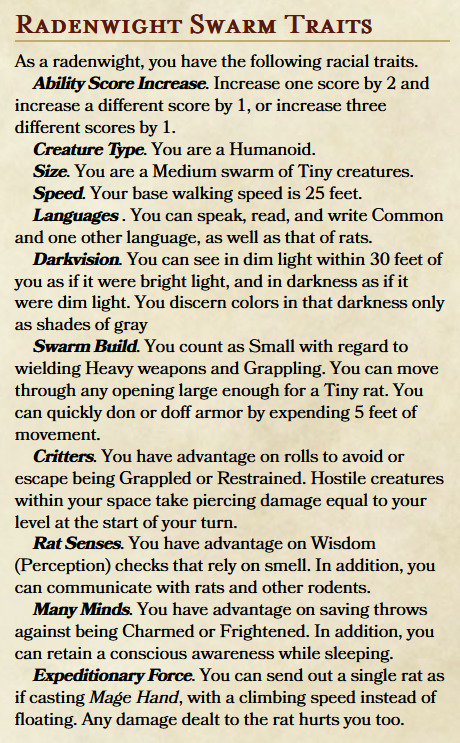
You ever wanted to just play as a bunch of intelligent rats pretending to be a human?
I sure did! I didn’t like any of the various versions of that idea i found, so i made my own, to procrastinate from my exams.
The idea is you play as the leader of a squad of rats that voltron together into a humanoid player character.
41 notes
·
View notes
Text
Fantasy Generators (D&D-ish)
Here are some of the random generators that I use for my dnd games, mostly as inspiration when im looking for some new ideas:
Fantasy Encounters
What do you find on your travels?


This is honestly my personal favorite, Im really proud of it and I find it very useful. I had a lot of fun with the combination space.
Fantasy Characters
Roll for a quick new person


Rolls up a name and a some rough character traits to get you inspired. It find it very helpful to drum up some quick starts for NPC’s
Fantasy Monuments
What do you find on your travels?


Rolls evocative locations and landmarks to sprinkle into your travels or as backdrops for fights, or maybe to be explored as dungeons.
Fantasy Artifacts
What do you find in the chest?


Gives inspiration for unique and new magic items and ancient artifacts.
Fantasy Epithets
What do they call you?


This was mostly just a fun little extra one to make fun evocative titles like in Beowulf or in Elden Ring, but I find it very fun.
Some of these are a bit tailored to the game im running (the Monument and Artifact ones mostly), but I feel they arent as useful if they are too generic. The good part is that the site allows you to very easily make a copy that you can edit to fit your setting, just switch out the terms for countries and so on so they fit your things :D
27 notes
·
View notes
Text
Easy-Roll D&D Setting v.2.5!






A fast and evocative guide to worldbuilding and creating a setting for D&D. Broken up into sections about the world in general, countries and regions, the guide asks questions with suggestions to inspire your imagination along the worldbuilding topics that are most relevant to creating a D&D setting. Now with a reworked and improved country generation (and other fixes)!
Homebrewery Link
PDF Link
51 notes
·
View notes
Photo
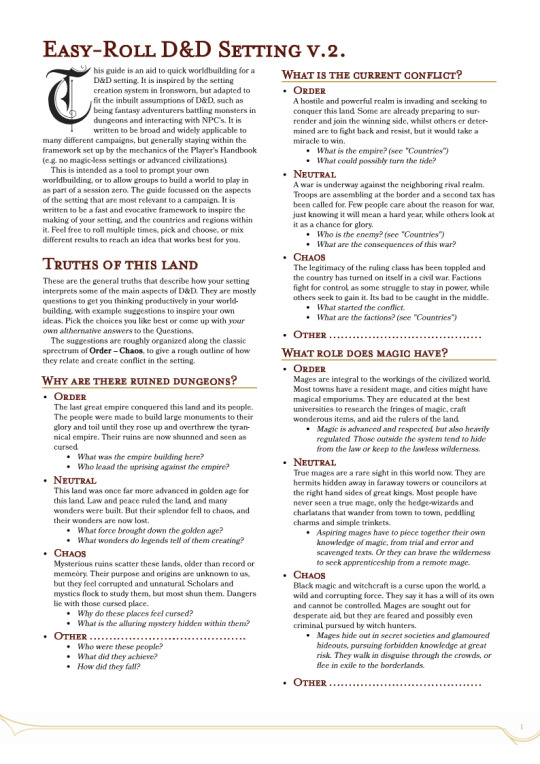
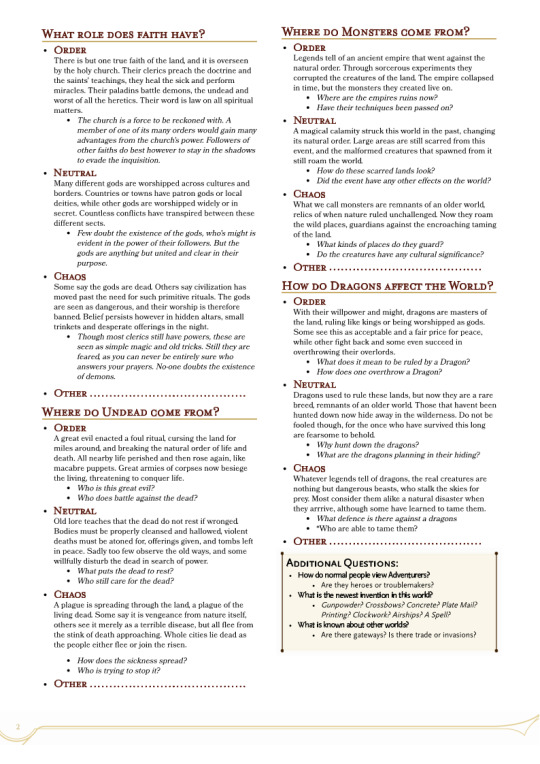


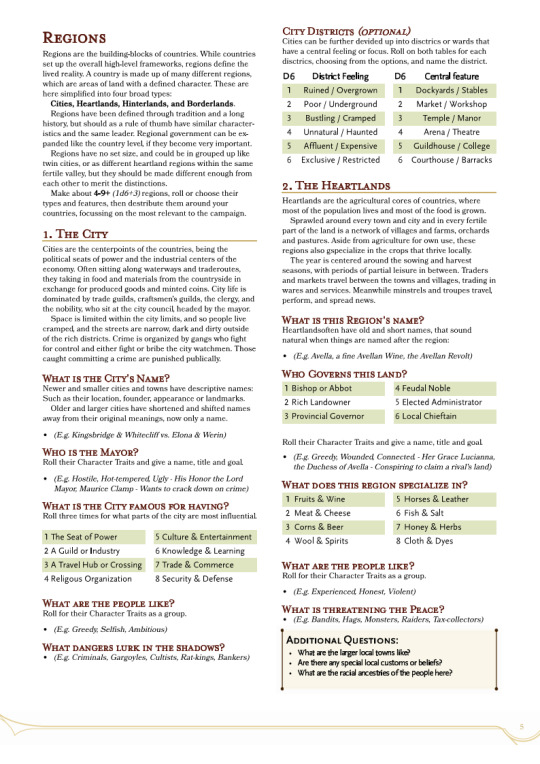

Here is the revised and expanded version of my Easy-Roll D&D worldbuilding guide, a fast and evocative guide to worldbuilding and creating a setting for D&D. Broken up into sections about the world in general, countries and regions, the guide asks questions with suggestions to inspire your imagination along the worldbuilding topics that are most relevant to creating a D&D setting.
(Source link)
205 notes
·
View notes
Text




The ferric oxide-rich soil of Hormuz Island in the Persian Gulf: perfect for metal album covers and vegan blood sacrifices.
13K notes
·
View notes
Text





This is the D&D Campaign setting worldbuilding guide I’ve been working on lately, and finally finished. Link here.
16 notes
·
View notes
Text
Easy-roll Worldbuilding: Underworld Gangs

First test of a bigger Easy-roll worldbuilding guide I'm working on, inspired by Ironsworns setting creator, but for a more general D&D Campaign setting. Just roll for the traits of your new gang, then come up with names that fits your setting and the combination of results you got.
29 notes
·
View notes
Text
A DM's Guide to PC personality creation.
As I've been running D&D, a thing I've found lacking in the advice given by the core rules, is on how you make your characters "softer" traits, those beyond the combat traits and abilities. Of course the advice given is very vague for a reason, since there are no limits to who you create, so they can't be too restrictive.
HOWEVER. What I've mostly seen result from this are some half hearted rolls to decide personality traits, ideals, bonds and flaws from tables, that are all so vague you pretty much just ignore them thereafter. I dissagree with that. I feel like they very much serve a purpose and be given the weight they need.
These traits i feel serve two basic purposes:
They are notes on how the PC is different from you, and how you should play them to reflect that. Basically directors notes to yourself.
They are a way to sell your PC as an idea to your GM, to get them interested in your PC and give ideas for what cool shit to have the PC encounter.
In both cases they are a zoomed out view of the character, looking at them as a creator. Although all characters are different, there are some broad features that make a PC fun to play as, and which helps your DM come up with fun things to play off them.
Motivation
Before we start on the others, I feel motivation is crucially left out, since it might be the most important.
Most PC are people who brave dangers and risk their lives on a daily basis. People like that generally have a reason for doing so. As a Player it's also much easier to play as a character who Has A Goal.
A tip is to break up Motivation into a short-term Want and a long-term Need. For extra points, the Want can be a step in achieving the Need.
Needs are often deeply lodged and personal, the driving force behind their being. The PC should not be fully formed and satisfied with their life from the start, and this should reflect that. This can be:
Avenging the death of a loved one
Finding a cure to a curse
Becoming famous and renowned
Never feeling weak again.
Making the world safer for their family
Proving their worth
Owing someone a lifedebt
Finding a purpose in life
This is a fantasy character, feel free to be as over the top dramatic and exciting as you want. This is Why you do what you do.
Wants are smaller scale and more easilly achievable, and therefore gain from being more concrete and specific. As mentioned above, they can be seen as the current next step in the epic plan to fulfill the Need. Most of them are about obtaining something, usually power, but not always:
Slaying a The dragon
Finding your lost sister
Gaining a powerful weapon
Protecting your boss' life
Confronting the witch
Spreading the tale of your deeds
Retaking your usurped title
Winning the championship
Escape the Prison
Killing that Jerk
Wants are more changeable and are just notes to yourself, as well as being what you Tell people when they as you what your goal is, if your Need is too private.
Needs and Wants can also be a way to signal to the GM what you want your PC to get, at the other side of a big challenge of course, but still.
Personality traits
Said simply, this is the reminder of how your PC is different from you, what they are defined by.
This part is mostly just a note to yourself, and some guidelines and adjectives for how your PC acts Differently from you. You dont need to write that your character is a hot gay mess if you always play those. You still can, but write something more that's Them.
Examples are that your PC is a:
Cantankerous old drunk
Clueless innocent zelout
Gristled burnt soldier
Angry, confident youth
Aloof, clever recluse
These are just examples, and the suggestions in the book are good, just remember to not choose redundant ones.
Don't feel bad about starting out with a personality that appears onesided, you can always develop them further and add complexity, the important thing is just starting with a Fun idea.
Ideals
Ideals can be related to your Motivation, but also describe how you act in everyday life. As with Personality, the important bit is showing how they are different to you and to the people around them. Most people try to Do Good or to Help their Friends, that's why they make poor ideals, since they don't really tell us much about You. Even the classic Chaotic Neutral choice of helping yourself is too .... Bland.
These are also lofty goals, and should be restrictive in some way, so it feels Exciting and Meaningful when you have to break them.
A good way to frame it is ALLWAYS/NEVER.
Never hurt the innocent
Always tell the truth
Never show weakness
Always oppose tyranny
I stick my neck out for Nobody
They should be Rules, to be followed, skirted, loopholed and in desperate circumstances broken. It therefore helps to word them precisely. You are the only one holding the leash on this, you still decide what your PC does, but a Code can help you have fun with them.
Bonds
Bonds are your PC's connection to the world. They express where you belong and anchor you. They also can end up being NPC allies or nemecies you encounter later on in your journey.
This is a chance for you to influence where your PC sits in world, and what parts of it you might encounter with familiarity in the future.
Write out your bonds to 1-3 people, groups, towns, or organizations. Note their name and how you are connected. More bonds are only of benefit to your fun as a player. Work with your DM to connect the bonds into the gameworld, so they might best utilize your bonds in the future.
Flaws
This can often be a tricky one. Players usually dont like giving themselves weaknesses, which is often how this is seen. So they try to make it as minor a weakness as possible, to not diminish the might of their PC. Well I'm here to try and Wisdom (persuasion) you to see them differently.
Flaws are what your PC needs most to improve on, a problem and conflict waiting to happen. They are a barrier stopping you from having yet become the person you want to be. They are a difficult hurdle still not overcome. They are a opportunity for you as a player to Choose a challenge to come.
For this reason, I advice against including disabilities and mental illnesses in flaws. By all means use them in creating your PC, but they should not be framed as flaws to be possibly solved.
You should also be very careful about giving your PC Flaws that overlap with subjects you yourself have difficulty dealing with. They are a challenge for the PC, not the player.
Flaws should actually be something you Want your PC to confront, whether that be a fear, a prejudice, an ignorance, stubbornness or hatred. Bad habits and coping mechanisms make for good Flaws. Things that can be improved over the course of play.
35 notes
·
View notes
Link
As someone who originally trained as a social historian of the Medieval Period, I have some things to add in support of the main point. Most people dramatically underestimate the economic importance of Medieval women and their level of agency. Part of the problem here is when modern people think of medieval people they are imagining the upper end of the nobility and not the rest of society.
Your average low end farming family could not survive without women’s labour. Yes, there was gender separation of labour. Yes, the men did the bulk of the grain farming, outside of peak times like planting and harvest, but unless you were very well off, you generally didn’t live on that. The women had primary responsibility for the chickens, ducks, or geese the family owned, and thus the eggs, feathers, and meat. (Egg money is nothing to sneeze at and was often the main source of protein unless you were very well off). They grew vegetables, and if she was lucky she might sell the excess. Her hands were always busy, and not just with the tasks you expect like cooking, mending, child care, etc.. As she walked, as she rested, as she went about her day, if her hands would have otherwise been free, she was spinning thread with a hand distaff. (You can see them tucked in the belts of peasant women in art of the era). Unless her husband was a weaver, most of that thread was for sale to the folks making clothe as men didn’t spin. Depending where she lived and the ages of her children, she might have primary responsibility for the families sheep and thus takes part in sheering and carding. (Sheep were important and there are plenty of court cases of women stealing loose wool or even shearing other people’s sheep.) She might gather firewood, nuts, fruit, or rushes, again depending on geography. She might own and harvest fruit trees and thus make things out of that fruit. She might keep bees and sell honey. She might make and sell cheese if they had cows, sheep, or goats. Just as her husband might have part time work as a carpenter or other skilled craft when the fields didn’t need him, she might do piece work for a craftsman or be a brewer of ale, cider, or perry (depending on geography). Ale doesn’t keep so women in a village took it in turn to brew batches, the water not being potable on it’s own, so everyone needed some form of alcohol they could water down to drink. The women’s labour and the money she bought in kept the family alive between the pay outs for the men as well as being utterly essential on a day to day survival level.
Something similar goes on in towns and cities. The husband might be a craftsman or merchant, but trust me, so is his wife and she has the right to carry on the trade after his death.
Also, unless there was a lot of money, goods, lands, and/or titles involved, people generally got a say in who they married. No really. Keep in mind that the average age of first marriage for a yeoman was late teens or early twenties (depending when and where), but the average age of first marriage for the working poor was more like 27-29. The average age of death for men in both those categories was 35. with women, if you survived your first few child births you might live to see grandchildren.
Do the math there. Odds are if your father was a small farmer, he’s been dead for some time before you gather enough goods to be marrying a man. For sure your mother (and grandmother and/or step father if you have them) likely has opinions, but you can have a valid marriage by having sex after saying yes to a proposal or exchanging vows in the present (I thee wed), unless you live in Italy, where you likely need a notary. You do not need clergy as church weddings don’t exist until the Reformation. For sure, it’s better if you publish banns three Sundays running in case someone remembers you are too closely related, but it’s not a legal requirement. Who exactly can stop you if you are both determined?
So the less money, goods, lands, and power your family has, the more likely you are to be choosing your partner. There is an exception in that unfree folk can be required to remarry, but they are give time and plenty of warning before a partner would be picked for them. It happened a lot less than you’d think. If you were born free and had enough money to hire help as needed whether for farm or shop or other business, there was no requirement of remarriage at all. You could pick a partner or choose to stay single. Do the math again on death rates. It’s pretty common to marry more than once. Maybe the first wife died in childbirth. The widower needs the work and income a wife brings in and that’s double if the baby survives. Maybe the second wife has wide hips, but he dies from a work related injury when she’s still young. She could sure use a man’s labour around the farm or shop. Let’s say he dies in a fight or drowns in a ditch. She’s been doing well. Her children are old enough to help with the farm or shop, she picks a pretty youth for his looks instead of his economic value. You get marriages for love and lust as well as economics just like you get now and May/December cuts both ways.
A lot of our ideas about how people lived in the past tends to get viewed through a Victorian or early Hollywood lens, but that tends to be particularly extreme as far was writing out women’s agency and contribution as well as white washing populations in our histories, films, and therefore our minds eyes.
Real life is more complicated than that.
BTW, there are plenty of women at the top end of the scale who showed plenty of agency and who wielded political and economic power. I’ve seen people argue that the were exceptions, but I think they were part of a whole society that had a tradition of strong women living on just as they always had sermons and homilies admonishing them to be otherwise to the contrary. There’s also a whole other thing going on with the Pope trying to centralized power from the thirteenth century on being vigorously resisted by powerful abbesses and other holy women. Yes, they eventually mostly lost, but it took so many centuries because there were such strong traditions of those women having political power.
40K notes
·
View notes
Text
why are star wars planets more boring than earth and our solar system like sure we’ve seen desert, snow, diff types of forest, beach, lava, rain, but like…
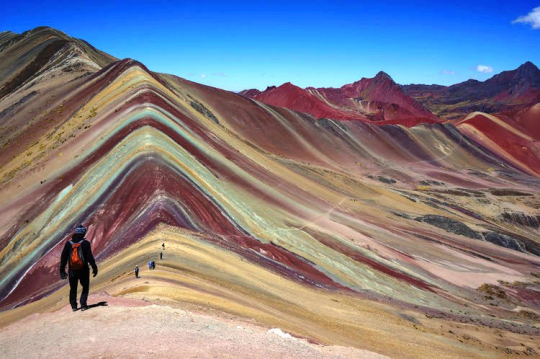
rainbow mountains (peru)

red soil (canada/PEI)

rings (saturn’s if they were on earth)

bioluminescent waves

northern lights (canada)


salt flats (bolivia, where they filmed crait but did NOTHING COOL WITH IT except red dust?? like??? come ON)

and cool fauna like the touch me not or like, you know, the venus flytrap.. and don’t get me started on BUGS like… we have bugs cooler than sw aliens
BASICALLY like???? come on star wars you had one (1) job where are the cool alien species
433K notes
·
View notes
Text
“I want to let you in on the dirty little secret of my field, Medieval Studies: The Middle Ages is incredibly attractive to white supremacists. For people whose vision of a backwards-looking, great world is one with white Christian men in positions of power and the rest of us put in our places, the Middle Ages is a fertile ground for fantasy, where it seems very easy, at least superficially, to ignore the integral role of an incredibly diverse population. There are legends like King Arthur, images like the Bayeaux Tapestries, and long histories of Crusading that, on the face of it, make the Middle Ages look very white and like a world very divided neatly into categories of “us” and “them.” This vision of a very white, very Christian Middle Ages has been a part of political rhetoric for rather a long time: Anti-feminist politicians exploit their idea of medieval chivalry and courtly love to give their ideas a historical grounding. The British Nationalist party uses the story of Excalibur to promote its vision of a racially pure England. The Crusades, in particular, have factored into that: Crusaders became a favorite theme of 19th-century Romantic writers and thinkers, whose refashioning of these tales were crucial to the creating the popular vision of a very white Middle Ages. T.E. Lawrence, the young British army officer who would go on to be known as Lawrence of Arabia and reshape the map of the modern Middle East came to that region as a student at Oxford writing about Crusader castles. Various European fascist movements throughout 20th-century have adopted Crusader rhetoric. More recently and in our own country, George W. Bush called for Crusade in the wake of 9/11. And the most recent presidential election saw a proliferation of images that have long circulated more quietly in the darkest, most racist corners of the internet that rely on medieval and Crusading themes and images to support both individual candidates and wider worldviews. But it’s not just political rhetoric: Attachment to a white Middle Ages is also an attitude that has absolutely permeated our cultural outlook: Look at something like the TV version of Game of Thrones and you see a kind of fantasy Middle Ages in which the race politics is incredibly uncomplicated, with a lily-white savior and her dragons redeeming the inarticulate, teeming masses of brown barbarians. It’s a rhetoric that politicians can use because it resonates with the population. But when we look at the actual Middle Ages in all its complexity, the possibility of this fantasy vision evaporates very quickly.”
—
“Both Sons of Spain”: Medieval Jews and Muslims in the Imagined Nation
My department held a round-table and teach-in yesterday in response to post-election Islamophobic and anti-Semitic vandalism on campus. We felt it was important, as scholars in the humanities, to offer a humanistic intellectual response to the changing tenor of campus discourse; we grounded this response within our discipline, with six speakers offering case studies of how different communities have responded to repression within the Spanish-speaking world. (The event was livestreamed and a recording will be available early next week; I’ll post it as and when.) What follows was my intervention. -S.J. Pearce
5K notes
·
View notes
Text
no but (among the 1424356 other things on my list) i so need to write a book about medieval history for a popular audience, just because the reality would blow people’s minds
there are so many things you can learn from it, so many misconceptions to destroy, and such an interesting social and cultural study of people learning to do things in different ways after rome fell. they had a period of almost 1000 years where classical culture was NOT the automatic standard. that is why we have gothic architecture and script. why they invented new literary and artistic genres, why they developed new laws. where, unlike in the ancient world, women and slaves were not relegated to a position of utter inferiority – in fact, slavery was abolished throughout most of the middle ages, and only began returning in the 16th-17th century when people were determined to replicate the criteria and legal systems of antiquity. same with women. you can find records of women doctors, bookbinders, copyists, shopkeepers, traders etc throughout the high middle ages. women religious were HUGELY influential; the abbey of fontevrault in france was required to have an abbess, not an abbot, in charge. queens regularly ruled whenever the king wasn’t around. it was only in 1593 that france, for example, decided to outlaw them from public/professional life. the salic law, made by philip iv in the early 14th century, barred them from inheriting the throne and later spread throughout europe, but that was not the case beforehand.
don’t talk to me about how “feudal anarchy” was a thing. feudalism was the last thing from anarchy, and it wasn’t about a lord mistreating or killing his peasants however he pleased. it was a highly structured and regulated system of mutual obligations – not a desirable condition for the serf, but still the bedrock on which society functioned. serfs were not slaves. they had personhood, social mobility, could own property, marry, form families, and often obtain freedom once they were no longer in an economic condition to make serfhood a necessity. abbot suger of france (late 11th-early 12th century) was most likely a son of serfs. he was educated at the same monastery school as the later king louis vi, ran the kingdom while louis vii was on crusade, and became the foremost historian of the period and partially responsible for establishing the tradition of ecclesiastical chronicles.
don’t talk to me about how everyone was a fervent and uncritical religious fanatic. church attendance on the parish level was so low that in 1215, pope innocent III had to issue a bull ordering people to take communion at least once a year. the content of clerical grievances tells us that people behaved and thought exactly as we do today – they wanted to sleep in on sunday, they wanted to have sex when they pleased, they didn’t believe the guy mumbling bad latin at them, they openly questioned the institutional church’s legitimacy (especially in the 13th century – it was taking assaults on every side as splinter and spinoff sects of every nature grew, along with literacy and the ability of common people to access books and learning for themselves). in the 14th century, john wycliffe and the lollards blasted the rigidly hierarchical nature of medieval society (“when adam delved and eve span, who then was the gentleman?”) partly as a result, wat tyler, a fellow englishman, led the peasants’ revolt in 1381. yes, the catholic church had a social and institutional power which we can’t imagine, but it was fought and questioned and spoken back to every step of the way.
don’t talk to me about how they were scientifically ignorant. isidore of seville, in the frickin 7th century, wrote books and books on science and reason from his home at the center of the andalusian “golden age” in muslim spain. toledo in the 9th century was a hotbed of theology, mathematics, and writing; admiring western european observers called multicultural, educated iberia “the ornament of the world.” in the 8th century in the monastery of jarrow in northumbria (aka in the middle of FRICKING NOWHERE) the venerable bede was able to open his “ecclesiastical history of the english people” with a discussion on cultural, linguistic, demographic, historical, geographical, and astronomical details, and refers to britain’s location near the north pole as a reason for its days being long in summer and short in winter (“for the sun has then departed to the region of Africa”). while bede’s information is obviously imperfect by virtue of his social and chronological location, he is a trained scholar with a strong critical sensibility and the ability to turn a memorable phrase; discussing an attempted imperial coup by an illiterate roman soldier, he sniffs, “As soon as he had seized power he crossed over to Gaul. There he was often deluded by the barbarians into making doubtful treaties, and so inflicted great harm on the body politic.”
don’t talk to me about how they were uneducated and illiterate. they were well versed in antiquity and classical authors through the high middle ages. they didn’t just suddenly discover them again when the 15th century started. the renaissance wasn’t about finding the texts, it was about deciding to apply them in a systematic way. beforehand, the 13th century saw the rediscovery of aristotle and the development of a new philosophical system to compete with the long-entrenched and studied works of plato. thomas aquinas and the dominicans were writing in this century. dante wrote the inferno in this century. i could go on.
don’t talk to me about the stereotype of the silent and oppressed woman – we already discussed that a bit above. i should also add, women usually had voting rights on the level of their community and this wasn’t regarded as odd. i already wrote a ranty post earlier on the myth that “it was just medieval times” and thus a rapey free-for-all.
we should also talk about how a form of gay marriage was legal for hundreds of years – two men could take wedding vows in a church and live together like any other married couple (though they called them “spiritual brotherhoods”). we should also talk about the cult of male bonds between knights in the 12th/13th century, and how it was idealized as the highest form of love. i also wrote a post a while ago about richard the lionheart and how sexuality worked. so.
we should talk about how all of this was happening in the time period that routinely gets written off as basically a wash between the fall of rome and the renaissance. we should remember that the renaissance was what led to modern structures of oppression for women, slaves, etc – everyone who had been worth nothing in antiquity. we should tear into the myth of historical progress and how it was invented to justify massive, wholesale colonization, genocide, and “civilization” in the supposedly enlightened 18th, 19th, 20th, and 21st centuries – because nothing we do now, apparently, can be as bad as what those bad ol’ bloodthirsty ignoramuses did back then.
we shouldn’t idealize the medieval era as a golden age either. that is never the right way to approach history. but we should take a long, long look at why we are so insistent on our simplistic, erroneous concepts of this time period, and how exactly they serve to justify our behaviors, mindsets, and practices today.
further reading to support any of these topics available on request.
5K notes
·
View notes
Text
Worldbuilding - Early Modern
Since so many seemed to like the earlier post on worldbuilding based on medieval Europe, I wanted to make a follow-up about another interesting and useful era for giving ideas for fantasy settings; the Early modern period, also known as the Renaissance (15th century). This is the era when the former medieval entities begin becoming more recognizable to us, and transition into being actual states as opposed to feudal lands owned by some dudes.
Before I begin, I want to disclaim that in making this, I am taking a lot of liberties in simplifying and generalizing these events to be above all useful inspiration for writing. History is always a beautiful fractal, always more complicated and interesting the deeper you dig into any subject. I very much hope you do keep digging, if any of these peak your interests.
Now, with no further ado, I present the Early Modern Europe of the 15th Century:
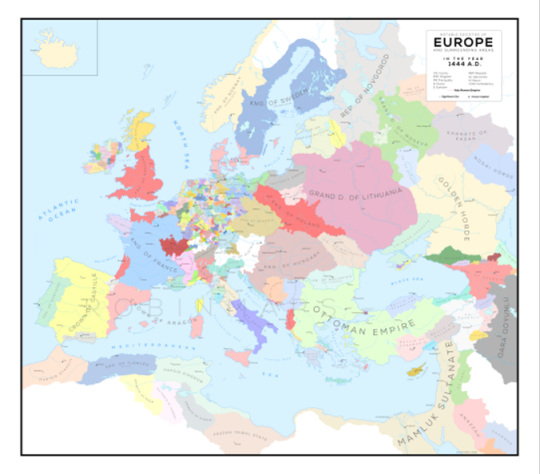
(As usual tumblr is terrible with maps, the better quality source is Here, and also extra credit to the guy who made it, he's really talented and his Etzy is Here )
This period is really interesting because you have bits of every era kind of all present, either the last lingering remnant of the past or the newly awaking future, all existing side by side. That dynamic I find utterly fascinating, and so I wanted to highlight a fair few, which could be re-purposed to flesh out a setting with Drama.
· Hundred years war
Likely one of the more widely known events of the era, the Hundred Years War was drawing to an end. The struggle that began with the Plantagenet King of England claiming the French throne from the local Valois family. This began the eponymous century of on- and off warring, with England at one point being near victory, France slowly regaining control, and the war ending in 1453 with France ousting the last English forces out of French soil. Soon after, the last Plantagenet English king died, ending the English claim to France after five generations fighting for it.
· The Auld Alliance
Aside from France, England had another long-term rival to continuously feud with, Scotland, and since the enemy of your enemy is your friend, the two mutual rivals agreed to an alliance. The alliance said that if England attacked one, then the other would strike them from behind. This made sure that their enemy could never focus all their efforts on one for fear of defeat at the hands of the other.
· War of the Roses
With the last Plantagenet King of England dying, there was a problem with succession. The two main heirs in question were each supported by one of the two greatest noble houses, the Yorks and the Lancasters. Soon each half of the country was backing either the banner of the White or Red Rose, and a civil war began. After decades of fighting, a peace was declared, with a Lancaster being crowned and marrying a York.
· Burgundy
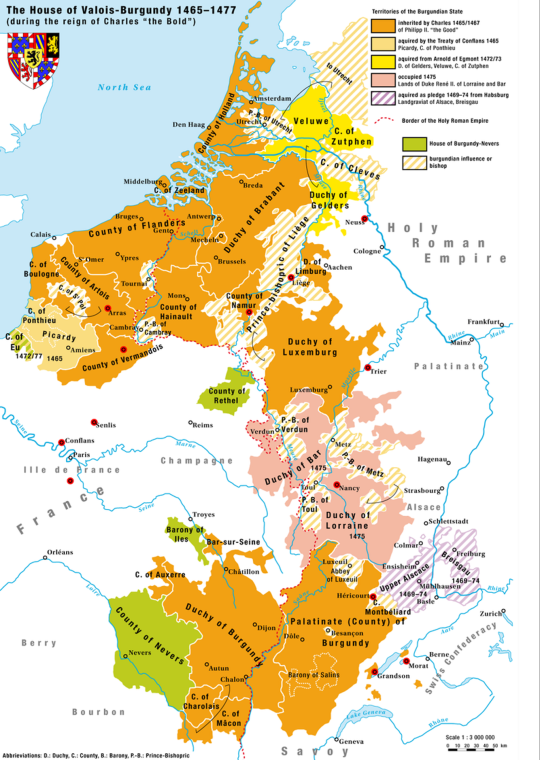
(Source)
The Duchy of Burgundy had always been a messy thing, being a fiefdom under both France and the Holy Roman Empire. It had often played the two against each other, as well as sometimes working with the English. Recently the Duke of Burgundy had also slowly gained control over a large part of the Low Countries, what would become the Netherlands. In this, he took the title of Grand Duke, and tried to go to war yet again with Lorraine and Bar to better connect his realms.
This ended badly though, with Duke Charles the Reckless being killed in a battle, with only his daughter as heir. The French king reacted quickly invading Burgundy to bargain for a marriage, but the daughter had fled the country to the Austrians, whom she wedded to keep her lands from the French. In the end, Burgundy was split in two, with France seizing their own fiefdoms, and the Austrians inheriting most of the Netherlands.
· The Reconquista (Reconquest) of Iberia
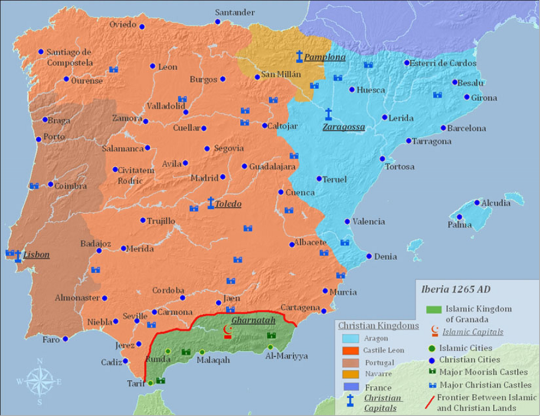
(Source)
The Iberian peninsula had been conquered by the Arab Umayyads in the 8th century, leaving only a sliver of northern territory remaining free. Over the next half century, with various help from other nations and holy knights, the former sliver would reconquest the peninsula, and become the kingdoms of Portugal, Castille, Narvarra, and Aragon. Now only the Emirate of Granada remained.
In 1482, having joined their kingdoms in marriage, the King of Aragon and Queen of Castille attacked and annexed Granada, ending Reconquista after 780 years. Soon after, all remaining Muslims and Jews were expelled from the peninsula, and the Spanish inquisition was started to find those who remained.
· Italian renaissance

(Source)
Many Italian states had gotten rich from trade brought from the Crusades, as well as new luxury goods like glass and cloths. The economy had also been booming from the newly founded banks and start of paper money.
As well as artisans fleeing from the fallen Constantinople, a movement bloomed in Italy, a humanist movement in art, a revisit of the now fallen empire in its glory, and a longing for a logic to the world. This is where we get out dramatic view of the artist, with examples like Michelangelo and Da Vinci, finding the divine in the human. They also really wanted new fancy ways to show how stupidly rich they now were.
· The Ottomans
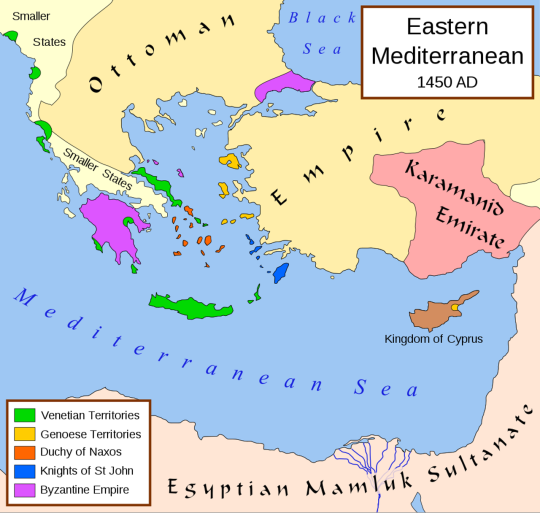
(Source)
The Ottomans had been a small local fief in western Anatolia, ruled by the house of Osman, until a power vacuum opened up and they rose quickly to the state of a major power by conquering all their neighbours. Crossing into Europe, they began conquering large areas of Greece and the Southern Balkans.
· The Crusade of Varna
In 1443, the Pope called for a Crusade against the Ottomans. They had just taken over Serbia, and the Pope called for all Christians to help drive them out of Europe. The call was answered, and the crusade was led by Władysław III of Poland, who was crowned the King of Hungary as well to bolster the crusade. They marched south from Hungary meeting no really resistance, until they did, at which point they were absolutely crushed, with even King Władysław dying, leaving his two giant countries now suddenly with no leader. This scared everyone in Europe from trying to stop the Ottomans for a good while, as well as plunging both Hungary and Poland overnight into political chaos:
Poland ended up accepting the Duke of Lithuania as the new king, uniting their two giant countries into one.
Hungary accepted the young Duke of Austria as the new king, paving the way for them to also become united.
· Fall of Constantinople
The Roman Empire, centuries in slow decline, had reached its last leg. Confined to mostly the city of Constantinople, it was but an cold ember remaining from the once giant pyre. Its massive walls had bought it time, but in 1453, the Ottoman army, with no one in the west able to counteract them, set their newly fashioned cannons to the walls and took the city for themselves, making it their new capitol.
· Heirs of Rome
With the last remaining part of Rome gone, no one wasted any time claiming to be the next successors of Rome. This had already been the case before, both with France, The Holy Roman Empire (I will do a whole post on them later), as well as the Pope, as both ruler of Rome and Pontifex Maximus of the Christians.
But with the Fall of Constantinople, new claimants rose up:
First were the Ottomans themselves, who having been related to the last Emperor, claimed it as his right.
The second were the Russian princes of Muscovy. After the fall, a Byzantine princess had fled up north, and married Russian prince, who then declared his seat of Moscow, the Third Rome.
This would only add to the growing animosity between the two great states, especially when they began dispute more and more about their borders.
The last heir, the actual brother and heir of the last emperor, hung out in Italy for a while, trying to get an army to reconquer his homeland, before giving up and selling his title to Spain for a comfortable allowance for the rest of his life.
· Free republic of Ragusa
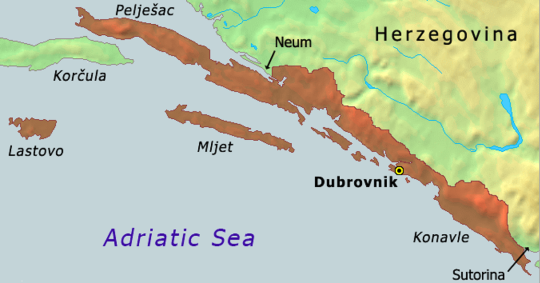
(Source)
Also known as the Republic of Dybrovnik, Ragusa was a small city state and merchant republic in southern Dalmatia. It had remained independent both through its massive fortifications, as well as a clever diplomacy.
With the growing Ottomans to the east, they agreed to become a tributary state, paying a yearly tribute to the Sultan, but otherwise remaining mostly free, and carved out their own importance from this new niche. The Ottoman ports were mostly closed to European merchants, but by trading with Ragusa, they could indirectly gain access to trade with the Ottomans. This mutually beneficial relationship gained the republic the Turkish nickname for "Good Venice".
· The Knights Hospitaller of Rhodes
Originally one of the first Holy Orders for the Crusades, when the Holy lands were lost, the Knights Hospitaller moved to a stronghold on the Greek island of Rhodes. Here they remained, becoming more and more fortified, continuing to raid their neighbors from the sea and disrupting trade. Made up of groups from all over Europe, they were a glorified destination for an interesting life.
When the Ottomans finally managed to bombard their fortress down, they fled to the island of Malta, south of Italy, and built even bigger fortifications and resumed their work, now mostly focused on battling the North African Barbary Raiders on the sea.
· The Mamluk Sultanate of Cairo
The Mamluks had been a caste of Circassian slave soldiers, employed by Muslim rulers all over the middle east, and especially in Egypt. Here they came to increasing power and importance for their priced fighting prowess, being more and more sought after and appeased. In the end they managed to seize power, overthrough the Sultan in a coup and established their own Mamluk Sultanate, taking over the upper class positions from their former masters.
With possessions across Arabia and the Levant, they held a monopoly on both the Silk Road and the Spice Trade, and making a fortune, requiring all trade going west to pass through Cairo. The Mamluks would also be an ongoing rival to the Ottomans, who very much wanted Egypt for their own.
· The Pontic Steppe
The area of current Ukraine and Southern Russia had lots of interesting things going on at this time. Called the Borderlands or the Wild Fields, was a hard to tame area, prompting interesting scenarios:
· The Golden Horde
First we have the Golden Horde, one of the Offspring's of the former continent-spanning Mongol Empire, still holding on to nomadic life, believing that settled living would make you soft and an easy target. The Horde used to have Hegemony over all the Russian Princes to the north, having the power to appoint and veto rulers on a whim. This power faded with time however, as the princes were either bought by-, inherited by- or conquered by the Grand Princes of Muscovy, who would go on to unite all of Russia.
· The Cossacks
With Mongol influence in Ukraine fading, others started to replace them. Politically this role came to the Grand Duchy of Lithuania. But the actual settling was mostly done by the Cossacks. Hard to define, the Cossacks were both settlers, armies and pirates across their territory. Staunchly hierarchical and democratic, they defended their lands and independence with both arms as well as burning insults. They were both raiders and priced mercenaries, with strict honor of their own making. They are in my opinion best characterized but this letter.
· The Crimean Khanate
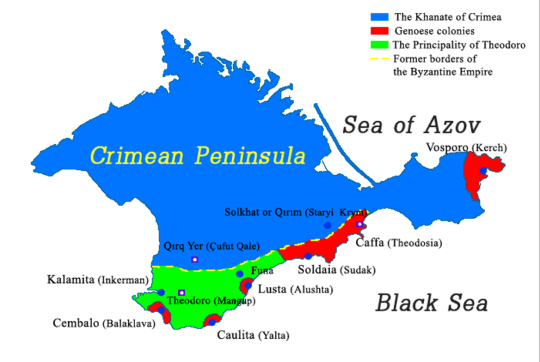
(Source)
Another remnant of the Mongol empire, the Crimean Khanate ruled most of the Crimean peninsula and a sizable area of the mainland. They were founded by Khan Hacı Giray as a separate entity to the Golden Horde, but after his death, a civil war broke out between his sons. One of them; Meñli I Giray, went to the Ottomans for aid, pledging allegiance to them in return for control of the Khanate. For a time they had a mutual partnership of Sultan and Khan, But as the Ottomans continued to grow and dominate, the Crimeans were slowly integrated into the empire.
· Principality of Theodoro
The last of a lot of things, this little principality was the last of the Greek settlements on the Pontic coast of the Black Sea, a system going back to ancient Greece and the Illiad.
By its other name however, Gothia, it was also the last in another respect. Populated mainly by Crimean Goths, it would be the last state of all the Goths, who conquered even Rome, a millennia before.
The small state would soon be conquered by the joint forces of the Ottomans and the Crimean.
· Genoese trading posts
Along the southern coast, we also have the remaining trading colonies of the Genoese republic, one of the thriwing Italian Merchant republics. The local main city of Kaffa, was especially prosperous controling trade in the Black Sea, as well as housing one of the largest slave markets in Europe at the time, trading slaves from the steppe nomads to western Europe These would also be conquered by the Ottomans and Crimeans. After losing their last colonies, Genoa would change lanes into this new Italian invention called Banking, and would soon be the de facto bank for both Spain and Portugal.
14 notes
·
View notes
Photo







In his travels Marco Polo vividly described the cold province of Badakhshan, a prosperous land where horses that descended from Alexander’s horse Bucephalus were once bred and where priceless rubies and the finest lapis lazuli were found.
Since ancient times lapis lazuli has been sourced in this remote region, north-east of modern Afghanistan, and exported over vast distances. Its mines on the steep Hindu Kush Mountains, above the Valley of the Kokcha River, can only be reached through a tortuous and dangerous route.
Lapis lazuli consists of a large number of minerals, including the blue mineral lazurite, the white mineral calcite and golden specks of iron pyrites.
A laborious process transforms this composite mineral into the pigment ultramarine; various grades of ultramarine can be obtained, from the purest extremely expensive deep blue, composed mostly of lazurite particles to the pale grey so-called ultramarine ash.
Our conservators recently attended a 2-day workshop learning how to make their own ultramarine pigment for use in our own conservation. See the entire process in our Case Study!
17K notes
·
View notes
Text
World Building - Medieval
Look, most fantasy has settled on a default setting of a quasi medieval europe-like Fantasy Land, and while it has some serious inherent flaws, like whitewashing and overused bigotry and misogyny for the sake of “Historical Accuracy”.
But my biggest problem with it is that its just Bland. Most of the places feel the same, with just different coats of paint and new names, there is rarely any interesting thoughts put into how the world works, since its just assumed to be the default. And i think its just a terrible shame because medieval Europe is such a vibrant and endlessly interesting setting.
Here I have a map of Europe in 1130 AD, just to pick a snapshot (X):

Can you see how much is going on here? A lot, which is good for us, bc it means more to steal from. But allow me to explain what you are looking at.
Going left to right, top to bottom:
In Scandinavia and Northern Britain we have the former viking nations now slowly transitioning into more settled societies, as well as being converted from pagan to Christian.
In Ireland we have the many tiny petty kingdoms feuding for control, while paying lip-service to:
England which had all too recently been overtaken by the Normans, who installed their new french Aristocracy
France is a mess so decentralized there isn’t any clear line for who is even part of the country, with the King of England paying fealty as he is also the duke of Normandy, and Brittany (the brown thumb sticking out) being its own little Celtic thing, doing the same lip-service as the Irish do to England
Next to France we have the bigger brother The Holy Roman Empire (HRE) originally the German part of the Frankish Empire, until the empire was split between the emperors three sons, quickly after which the middle brother was attacked from both sides got split up and fought over ever since. The HRE is a mess so complicated im gonna do a whole other post about it, but its pretty much about 300 countries squeezed into one giant one.
Then in the reds we have the first unified and christian state of Poland, which would quickly be divided among the sons again. The country is both in conflict with the neighboring Germans as well as:
Old Prussians and Baltics, pagan tribes who both in-fight and get frequently invaded by the next door Christians, the last remainder of the Romuva
Then in the greens, we have the river-trading Kievan Rus, who always remind me so much of Rohan, only with riverboats instead of horses. They were city states that worked the plains around then and traded with the Romans in the south and the Germans and Scandinavians in the west. They were is frequent conflict with:
The Steppe Hordes (in brown and yellow), who spread out over the vast flat grassy steppes that go from Hungary to Korea, mastering the art of horseriding and archery and being able to move around faster on land than anyone else on the globes for many centuries. Mostly they were nomadic and pastoral, living off their horses, they would also frequently raid their wealthy settled neighbors, for the plunder and tribute.
Speaking of Hungary (in orange), in the northern Balkans, surrounded at all sides by hills and mountains is the large fertile valley, which is home to to the Magyars, a former steppe horde, that invaded and conquered the valley and settled, slowly turning into the large kingdom of Hungary.
Jumping west to present day Spain, we have the Iberian Peninsula, which was for a long time ruled by the Caliphate of Cordoba, conquering all the way up into France. Slowly however, there has been a pushback, as the new militarized kingdoms of Portugal, Castille, Navarra and Aragon are working their way south over the course of many centuries.
In Italy, aside from the HRE,
We have the Merchant Republics of Genoa, Pisa, Amalfi and Venice, who fought over trade in the Mediterranean, with the Holy lands and especially rights to the lucrative trade with the Muslim Caliphates, who had access to both the Silk Road and the Spice Trade.
Then we also have the Pope, who apart from being the head of all the Entire Catholic Church, was also the king of his own realm, the Papal State.
At last in the south we have Sicily, which was a Norman and French controlled kingdom, which had been conquered in a crusade from the Emirate of Sicily.
In Greece and Anatolia (in purple), we have the remnant of the Roman Empire, the Byzantines, although they at no point stopped thinking or referring to themselves as Romans. Here a remnant of late antiquity remains, ever trying to regain its old glory. Rejecting the Pope, they hold to the old Orthodox ways of the Patriarchy and spread their influence out in competition with the Catholic West, as well as the Muslim East.
The Caucasus is a long strip of land between two seas with a bigass mountain-chain going across the middle, and making it very hard to cross. The locals very much like to keep it this way: Here in a valley up against the mountains, we have the Kingdom of Georgia, a land of wineyards and fiercely defensive warriors, holding off both the much larger Caliphates to the south and the other mountain tribes to the north.
Going back to the west we have the coast of North Africa, where we numerous smaller states either under control of Cordoba in Spain or the Fatimid Caliphate in Egypt. Here they live on the livable strip of land between the sea and the desert, sailing north to raid the christian lands to the north.
From here there is the great trek, trading caravans crossing the Sahara south to goldmines of the Mali Empire, home of the richest man in the human history, King Mansa Musa, whose wealth would have been immeasurable by any standard we have today, whose Hajj to Mecca was so splendid and charitable that it crashed the global gold market for a decade. A largely isolated kingdom, it flourishes from the bountiful caravan trade.
Along the coast of the easternmost Mediterranean, we have the newly formed Crusader States, formed in the first crusade, where the squabbling crusade leaders competed and carved up their winnings into their own small kingdoms. Here is a mix of locals, pilgrims, holy orders and Italian merchants all trying to carve out a success.
Further in we have the Abbasid Caliphate, enjoying the prosperous times of the Late Islamic Golden age, with bountiful harvest, the spice trade and silk road, and a unrivaled creation of knowledge in the Baghdad House of Wisdom, one of the largest universities and libraries in the world. To parallel the Christian holy orders, we also have the shia Hashashin Order, who come down from their mountain fortresses to assassinate those they see as a threat.
This is just a very quick overview, and most of these would change over the course of a century. This is mostly to show how there has never been a Fantasyland-esque static world of same-ish kingdoms, that is a simplification made because there is no way to get anywhere near the complexity of the real world when we are making a work of fiction. That way leads to an encyclopedia.
So we make shadow-puppets, abstractions, we use shorthand and likenesses to well-known history to not have to explain what a king is every time. But the problem arises when it becomes a copy of a copy, an abstraction made from other abstractions. This can make the world bland and makes it difficult to then add back the interesting details. That’s why i think its way better to steal inspiration from the source, before many of the good stuff has been filtered away.
In general Things Have Always Been Messier and More Interesting Than You Think:
369 notes
·
View notes
Text
Worldbuilding - Regions
One thing I’ve found a good way to think of geographic world-building is that instead of thinking of countries as singular Things, to instead think of them as a collection of regions. This, for me at least, helps shift the mindset into a way that helps shift the mindset from countries being vague blobs with a ruler and an ethnicity.
This is kinda how (vaguely, there are always more exceptions) real countries have been, especially further back, when centralization was a lot harder. The whole grand Land would be broken up into fractally smaller regions, nested into each other like many Russian nesting dolls.
A grand Empire broken up into Kingdoms, broken up into Duchies, broken up into Counties, broken up into Baronies and so on.
The names change, you can have provinces or states or dominions, but the general theme is that different areas have to be handled in different ways and so the land is divided to accommodate that.
This is not to say you should make up a whole feudal bureaucratic mess for every country you mention in your fantasy Rom-Com. The key to good world-building is to always stay at a manageable size and expanding when you need it. A good way to save some effort is to use this idea to more easily give character to the surroundings.
The story might take place over three different distinct regions, despite being contained in the same country.
A region might be split up by two feuding empires.
A character might hail from a very distinct and different region than the rest of the group and have a close connection to it that goes above what ever allegiance they might have to the ruling monarch,
etc.
What a region might be can vary immensely, which is one of the reasons i like it a lot as a concept.
It could be simply be a piece of land bordered by rivers or hills in such a way as to be easily held together.
It could the stretch of hills themselves, inhabited by herdsmen or hard to rule bandits, both of which would have their own culture and require a different governance than the rest of the country.
It could be an island, cut off by nature, and easily developing an independent identity
It could be the homeland of a specific people who make the land their own.
It could be a prosperous city with its own culture and character
Farmland is different from Coast is different from Steppe is different from Valley.
Geography can help inform and guide a lot of the basic world-building, and this is a way to ease the load by zooming in to a smaller area and seeing what it looks like. We all know our own local area and how its different than the one over, the same would be true of the people in our stories
24 notes
·
View notes